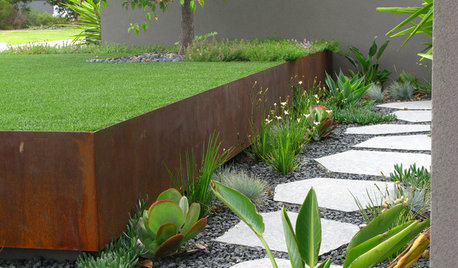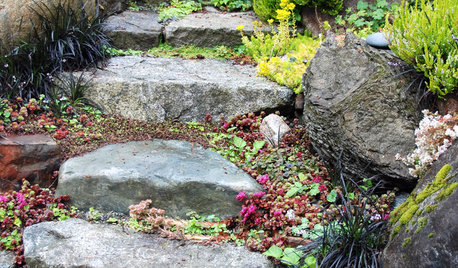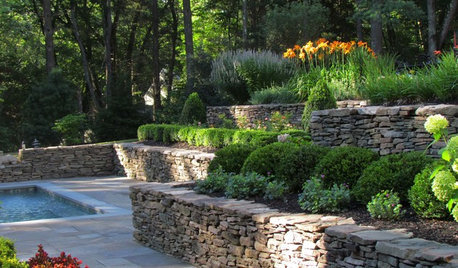Size of stepping stones
I don't have a Japanese garden -- it's more of a native New England woodland garden -- but someone on the Gardening with Stone forum suggested I post this question here:
How big should my stepping stones be?
I've done lots of research but I can't seem to find much on this subject. I'm using flagstone to create a winding stepping stone path through my yard -- total length about 110 feet. I've dug out a trench 8 inches deep and 40 inches wide. I plan to add five inches of gravel, then place smaller round stones as edging, then add two inches of sand, then place the stepping stones and level them, then fill in with soil and start growing moss. The only reference that mentioned size said the stones should be at least 18 inches wide and 3-4 inches thick, and should be placed with the longest side across the path, not along it. (G. Hayward, Garden Paths.)
(The latest input from the Gardening with Stone forum -- 12 inches wide, 25 pounds minimum, 4-6 inches thick, but preferably stone should weigh as much as person stepping on it. 200 pounds?)
I have yet to see a design that resembles mine -- most stepping stone paths don't have stone edging, or any edging -- but I have several reasons for doing it this way (which I'll spare you unless you think it would be helpful).
Any advice appreciated,
-- wd
Comments (23)
edzard
19 years agolast modified: 9 years ago--wd,
the pattern you are thinking of is very common in Japanese gardens, with the biggest question for what size, being, how many people at a time? Private walk? public walk? Level for safety or irregular to give a sense of distance?
Small stone may be used, set on edge, or a thrown hail pattern, how large are your feet? will elderly people be using it? or....
endless reasons/combinations.The weakest point of this type of path are the side edges, therefore, most often the largest stones are placed first on the outside edges, then the interior is of smaller stone, with the suggested traffic path of larger stone through the 'middle'.
Of patterning: placing them longest side across the path is a path that suggests 'stop!, stop!'. An angle suggests 'look this way, diversion while walking",--- in line, suggests go fast. Non-descript wide stones are path splitting or viewpoint stones, pause here.
By example, if animals follow a 'line' path, and we follow a line of road or sidewalk, then doesn't it make sense that the visual direction of the stone would suggest what activity we are to follow from the path?
Crosswalks are a favourite example. The ones where white lines are painted at 90 dg's to the pedestrian are most humourous, and deadly,.. because the white lines block ones path with every step, and in turn are 'go fast' lines to the vehicular traffic, mimicing the passing lane on a highway. Now who thought of that wonderful idea for saving lives.....??--- point being, set the stones that evoke what you wish the pathway pedestrian to do first, then fill the remains in with the fill stones, whether large or small is irrelevant as long as it is conducive to the action the walker is to take.
for curiousity I mention that the negative space,- the eventual lines of moss are the focus of the design, noting whether this line is pleasing or not. A side bar to this is that all stones are ideally placed with 2 points together and any other bypasses these 2 points. 3 points cause a focal star pattern to emerge which may negate the purpose of that portion of the path.
In this broad overview, I would use the substrate you are thinking of with a twist. I would use mortar to set the small stone, pick it and allow moss to grow on the mortar, alkali loving moss is finer and tougher than acidic moss (least where i am). The mortar will crack and provide a firmer sidewall support for the smaller stone than sand. If lighter step stone was used, then set the stone and firm mortar around/under. Even concrete could be used, colored if necessary, etc. etc.
edging is normally used to assist in keeping the feet dry, adding a 'clean' design element, water runoff, leaf gatherer/maintenance, etc.
what are your reasons for edging?edzard
Related Professionals
Redondo Beach Landscape Architects & Landscape Designers · Wixom Landscape Architects & Landscape Designers · Aurora Landscape Contractors · Hicksville Landscape Contractors · Lake Saint Louis Landscape Contractors · New Braunfels Landscape Contractors · Watertown Landscape Contractors · West Chester Landscape Contractors · Camp Springs Landscape Contractors · Hampton Bays Decks, Patios & Outdoor Enclosures · Little Rock Decks, Patios & Outdoor Enclosures · Littleton Decks, Patios & Outdoor Enclosures · Monroeville Decks, Patios & Outdoor Enclosures · Randolph Decks, Patios & Outdoor Enclosures · West Chicago Decks, Patios & Outdoor Enclosuresinkognito
19 years agolast modified: 9 years agoThe river mole runs its course through a valley around Dorking in Surrey. Beneath Box Hill near Mickleham and set in concrete is a way across the water known as "The Stepping Stones". To get across with only one step on each concrete plinth without falling in is open only to those chemically enhances athletes recently seen in Athens. With kids there is usually a fear trembling midway stage and for teens it is a right of passage. Stepping stones in your own back yard should not be a challenge, with or without a gold medal. If each stone allows you two steps without falling in the water you have cracked it. Stepping stones set on the perfect bed that have you playing hopscotch spells a wasted summer.
edzard
19 years agolast modified: 9 years agoINKcognito, quite right.. comfort and safety, and the edge concerns me a bit...
--wd,..
the mortar is to hold small round stones in place. It is not seen, soil goes over it for moss, or in my case, moss grows right on it.
-in the case of round stones that you describe, gabian or fist to head size stones are used with the flatest side up, which may be round. In turn the mortar firms the stone as a claw a diamond in a ring.
My concern with soil on sand is that stone moves when stepped on, on a fulcrum principle, which equals endless maintenance.For edging, many things may be done. For one, underset branches/log effects..
I would tend to approach one portion of the path before another, ie: the incline, then could be a log, to step up, one tier at a time.yet, back to stones and paths..
does Herb or someone still have the URL for the PBase set of nobedan paths?
pick a technique of using stone, then solve that portion of the path edge..
for me.. the twin rows of vegetarian teeth don't do too much, since they attract too much attention in that area, as well as being risky to use for little feet.Which part would you like to resolve first?
was your work wasted? not in the least, imo.
edzardwell_drained
Original Author19 years agolast modified: 9 years agoOnce again, excellent thought-provoking comments.
INK: According to my research, the ideal distance between stones is 2-12 inches, with several authorities settling on about 6 inches. They also say to walk the path and note where your feet land (and maybe have someone else, spouse for example, do the same) to determine stone placement. Another piece of advice I got was to make sure the space between the stones is smaller than the stone's breadth.
Edzard: I'm glad you're still hopeful, because I'm rapidly losing faith in my design. I guess one alternative would be to jettison the stepping stone idea altogether and just do a trodden earth path. I don't think a 'stone carpet' would work on the slope, plus I don't think I can afford all that stone.
I found a picture that has some of the elements of the path I envision. (See link.) The only differences would be that my stones would be surrounded by earth, not gravel, and there would be little rounded mango-sized rocks at the juncture between the path and the greenery -- in this example, the rocks (which would be buried 3/4 into the base) would be hidden under the overhanging branches. (I suspect there is some hidden edging in the pictured path, too, otherwise the gravel would spill into the beds.)
This is the first time I have heard that there is a problem with setting stones in sand -- it seems to be a very common practice, especially in New England, where frost heaving is a common occurrence. It seems to me that the flexibility is a positive, not a negative aspect of the design. I still have a problem with the mortar idea -- imagine yourself hiking through a state forest -- most of the path is just trodden earth, but in a few areas, there are stepping stones, either natural or placed by the park rangers to ease movement, or protect hikers' feet from muddy areas (or protect the muddy areas from the hikers' feet). This is what I want my backyard path to resemble. I think if I were hiking in the woods and I came across a path of stones set in mortar, I would find that jarring and out of place.
I guess another alternative would be to back fill the trench with all the rocks, then fill the rest with dirt, then tamp it down, dig individual holes for the stepping stones, put an inch or so of sand in the holes, tamp and level and lay the stepping stones in them. Then I wouldn't have to worry about edging, or putting soil over sand. And I could still grow moss on the soil in and around the stones. (The only practical problem with this approach is that I spread the dirt from the trench all over the yard, so it will be difficult to find enough soil to refill the trench, and I don't like the idea of importing foreign soil into my yard, since my planting design is based on the specific characteristics of my soil.)
Thanks for all your thoughts, insights and advice. I will report back.
Here is a link that might be useful: Stepping Stone path
well_drained
Original Author19 years agolast modified: 9 years agoI've been googling paths to find something similar to my conception, but I only find approximations. Here are three:
#1: http://itc.tamu.edu/documents/Public%20Service%20Project/images/formal%20garden%20path_JPG.jpg
Not clear if these are edging stones or stepping stones.
#2: http://webhome.idirect.com/~rbebout/bar/pix7376/comox.jpg
Imagine this one with fewer, larger stepping stones, and fewer edging stones, but with more room between edging stones and stepping stones.
http://members.evansville.net/nikko/Mary/s%20nanako-mvp1a.jpg
Very strange edging here seems to lack purpose. Imagine row of low rocks instead.
jeepster
19 years agolast modified: 9 years agoAnother consideration is the need for garden carts, two wheeled trucks and wheelbarrows. I made the mistake of putting in a stone path around the backside of my house as a sidewalk and it,s imposible to move heavy objects into or out of the house with two wheelers or even lugging by hand as your feet catch the stones.
edzard
19 years agolast modified: 9 years ago--wd,..
I guess I don't get the picture, :)unseen mortar bothers you, shrug, you could use clay or some other firming solution that keeps small stones where they ought to be.
perhaps a different way of approaching the situation: if you have the material of 'rounded' small to large stones, how will you use them to obtain the results of 'the path', saving on importing flagstone... or other material.
design solution, what is it?http://www.urasenke.or.jp/texte/tearooms/roji.html
http://www.aisf.or.jp/~jaanus/deta/a/ararekoboshi.htm
jaanus does not contain jpegs of all the types, though jgarden.org may have some... have not had time to check.
library, looking for Japanese garden books on paths would also give suggestions.
or post a jpeg of the site, design solution by sight...
edzardinkognito
19 years agolast modified: 9 years agoI am not sure you got the answer you were looking for WD. As often happens basic questions are asked somewhere in the middle rather than at the beginning. You want your path to look like one cut through the woods, a path that has been created by the creat ures (clever hey?) that walk that way. Now somehow or other you have found yourself on a forum that walks the Japanese way.
In a, not so smart arsed, tone: in the old days these paths were made from what was cleared from the furnace (clinker) or small stones sifted out of the garden soil. Not Japanese but natural and practical. The most successful stepping stone path I made, and remember what I said earlier about 'stepping stones' was in a new garden that had top soil 4 inches thick still loose. Two people carried the big flat stones, the technology was that used on the pyramids. I was the slave master. The two slaves dropped the stones on my command, their weight (the stones) displaced enough soil to set them without further tinkering. We raked around, put down the sod and Ramses is your uncle.
So, back to being a smart arse, if your stepping stones come out like stepping stones it has to be intentional.Gorfram
19 years agolast modified: 9 years agoEdzard, your thoughts on sidewalks remind me of the philospher who finally proved that white was black, and then got himself killed at the next zebra crossing :)
Inky, you don't honestly expect me to believe there's a place called "Dorking" in Surrey, or anywhere else, do you? :)
And what's a "river mole" anyway? Is it like a chocolate mole, or like a river rat? ;)OK, down to business: WD,I like the idea of your path, as if the stones just happened to occur where they are most convenient for human travel, and understand it to be very much in tune with what I think Japanese gardens are about.
For size and placement of stones, I'd sprinkle flour or lime or some other foot-printable substance down the path (they say snow works well if it's handy :), then send everyone in the family and/or neighborhood up and down the path a couple of times. Then draw big circles around the closest concentrations of footprints, and find stones of roughly those shapes and sizes.
You haven't wasted anything digging out your trench, which will allow to set your stones properly and firmly. I think you're doing yourself a disservice in discounting the idea of using mortar carefully hidden under the stones - they need to be kept upright and in place somehow (you don't think all that natural-looking beauty is going to come *naturally*, do you?).
But even if you just set them in with wet sandy clay, being able to backfill those four inches around them with supporting stones and sandy-clay-mix should make a world of difference in the ease and quality of the work.I also agree with Edzard about not having a row of rounded stones poking up as the edging. *If* you carefully placed staggered lines of stones of varying sizes, as you would at the edges of a stream, it wouldn't be bad, but IMHO, it would still look a bit odd unless you scatted plenty of small stones in the interstices between the steppers and the edgers.
If you want a fairly straight lines of similarly sized stones, you might want to split them to get nice flat surfaces for the exposed side. (Just think, while you and your SO might never fling yourselves down on the pathside for a little al fresco in flagrante, it would be so much nicer if you more-or-less comfortably *could*.)Sounds like it's a lovely site, and a great project for it.
- Evelyn
Herb
19 years agolast modified: 9 years agoEvelyn -
I nearly spilled my coffee over my keyboard when I read your philosopher story. LOL!
But I can assure you that there is indeed a place called Dorking in Surrey, and there is a River Mole -
Herb
19 years agolast modified: 9 years agoEdzard - You mentioned Nobedan path pictures at Pbase. Perhaps this is what you had in mind? -
Gorfram
19 years agolast modified: 9 years agoSorry to have been the cause of a near-accident with the coffee, Herb ;)
[The tale of the sad demise of the philosopher who proved white was black is actually stolen from the author Douglas Adams.]And either Inky has subverted both your unsubvertible self and the highly suspect "Ordnance Survey Route Travel Map of Great Britain 2003", or the English are even more creative with town names than I had previously thought.
:) Evelyn
edzard
19 years agolast modified: 9 years agoYes Herb,.. thanks.
--wd the one in the upper left corner would be a use example for the concept of the area going from inhabitation to the wilder 'in the forest' path of 'while I was there' pathway construction.
please note the subtext of stone, in the serpentine pattern through the middle, indicating the speed of travel and beginning the sense of 'forest wandering'.
This effect begins to relax the brain to accept continuously relaxed stone settings, if any are even used.From this pattern, the path simplifies to just the serpentine track stones, changing sizes to more 'off-hand' placed stone, which in the end may be just a track through the forest with an occasional stone at important intersections...
--and there are unlimited ways of achieving the same results (what the brain senses) with whatever materials are at hand or if you wish imported.or is this not what you had in mind?
edzard
Herb
19 years agolast modified: 9 years ago"or is this not what you had in mind?"
Edzard, to whom were you putting that question? I hope it wasn't me!
edzard
19 years agolast modified: 9 years ago--wd, Herb.....
"--wd the one in the upper left corner would be a use example for the concept of..."
eHerb
19 years agolast modified: 9 years agoEdzard -
I'm afraid this is another instance of the duck & chicken having different thought patterns. The duck's preferred mode of analysis is to just look at the path and ask itself - "do I find it pleasing to my eye?" It then gives 3 quacks of approval.
well_drained
Original Author19 years agolast modified: 9 years agoActually, the Pbase path in the lower right hand corner is the closest to what I have been imagining -- only with rock edging instead of wood, and fewer stones in the middle. And soil on the surface instead of gravel. So I guess it's not very similar at all, when you think about it.
Here is the question then. Let's assume I trash the idea of stone edging, but I still fill in the trench with 5 inches of gravel (and tamp it down) and two inches of sand (and tamp it down). Let's say my stepping stones are laid in a row, usually one at a time, but maybe two at a time for smaller ones. Let's say the stones are 18-24 inches wide and 12-18 inches long, and 3-4 inches thick. Let's say there is a distance of at least one foot on either side of each stone that has a base of gravel and sand. Let's assume I put an inch of soil down around the stones to bring everything to grade, tamp that down and plant moss on it. Is it OK to just let the path abut the garden beds on either side, with nothing in between? Not just aesthetics, which are in the eyes of the be-boulder, but engineering -- I read a lot in my how-to guides about path base materials spilling out onto the garden beds, especially dry laid stone paths. (Sorry, I just can't do the mortar, even subterranean mortar -- maybe this is a prejudice, but I don't want cement in my yard (except the house foundation -- it's ugly, but it seems to work pretty well)).
The comments about huge 200 pound stepping stones are fascinating, but I'm not about to attempt anything like that. I've walked on many stepping stone paths and seen many more in books and on web sites, and I would guess that very few of the stones in those paths weigh as much as the people walking on them. I will have to settle (pun?) for less weighty stones and hope that they will find comfortable resting spots. (Those adorably cute little round do-it-yourself stepping stones with amusing little sayings look to be about 12 inches in diameter, if that, yet some people seem to be able to make stepping stone paths with them.) (I didn't say good stepping stone paths.)
Finally, if I decide to take your advice and get rid of the edging, what the heck should I do with all these thousands of rocks? Dozens of piles of them all over my tiny 1/8 acre yard just isn't working for me. (I haven't been able to move several of the larger ones out of the 9X8 area I've dug into the slope to make a small patio. It looks like a dinosaur nest.)
Thanks for taking the time to ponder these practical and ethereal questions with me,
-- wd
edzard
19 years agolast modified: 9 years ago-wd,..
I guess your real problem is those pesky little stones. I suppose they could be re-interred as part of the gravel bed.. shrug, there in lies the solution, what will you do with those stones.personally, I'd use them visually, figuring out a way. Otherwise you could use them as a base for the crush, saving on the total number of wheel-barrows of crush you will need.
in response to the edging, easily you could bypass the edging stones, though I would be inclined to reinforce the garden edge, and plant carefully so that maintaining the weeds between the stones is not too much work. End question will be whether your moss is stronger than your weeds. Gravel is a pain to weed.
bottom right hand corner jpeg... being a western version of path that is designed to attract attention to itself, is... something that my eyes do not appreciate, nor I suppose find applicable to a forest, if one must, then the entry to the forest much as the opposing corner suggestion. Both do the same function, one uses your pesky stones, in the other you will import your stone.
your money, your choices, your labour... how hard do you wish to work?.
edzardGorfram
19 years agolast modified: 9 years agoLower right hand corner is one of those gawdawful cast-your-own-stepping-stones homemade concrete jobs: see how the patterns repeats every few stones. (That would allow you to cast in those lovely little messages like "Bee Yourself" and "Bloom Where You're Planted", WD ;)
But you said yours would be not very similar at all. Whew!
I think Edzard is right, and the problem is what to do with all your pesky little rocks. I belive the tradition in your neighborhood is to build drystone walls, whether you need them or not :) But you could also:
1.) Get a big sledge hammer, and spend the winter making them into the gravel that you will need for your new path (wearing striped pajamas and singing "Working on a Chain Gang" is optional :)
2.) Call up your local stoneyard and ask if they're buying.
3.) Post them on the GW garden exchange.
4.) Call up your nearest Living History/Historical Re-enactment site, and ask if they'd like a bunch of cobblestones.
5.) Buy a really big sunlamp and hatch dragons :)
BTW, just beacuse they *sell* 12" round stepping stones doesn't mean that's a good size for them. Try walking a path of them: you have to place each foot carefully so as not to partly miss the stone. If they're in a straight line, they come pretty close to functioning as a sobriety test (and who wants *that* in their garden? ;)
Cheers,
- Evelyn
well_drained
Original Author19 years agolast modified: 9 years agoGorfram -- The main similarity between the lower right hand corner pic and my original conception was: raised edging, stepping stones in center of path, and space between edging and stepping stones. Otherwise, the picture is nothing like my conception (particularly the look of the stones themselves).
Maybe part of what makes this discussion complicated (but interesting and helpful) is that I don't have a Japanese garden (as I stated in the first post). I have a layperson's idea of a Japanese garden (which I'm sure is completely inaccurate): formal, clean lines, integrated into the landscape but somehow apart from the landscape. Even the name "Japanese garden" indicates importing something foreign into the natural landscape. (I'm sure you will correct any misunderstandings.) My garden is going to be informal and will take its cues from the natural landscapes of New England (yes, dry stone walls are a common feature, and may be the answer for some of the larger rocks). So the path should fit into this conception -- informal, even a little messy (most of the paths in the post above just looked too darn neat, with sharply defined edges that seemed to rise up from the ground level as if you are on some kind of pontoon bridge over your garden, instead of down deep inside your landscape).
But, these may be pipe dreams. I have a tiny sloping plot, with five abutters (each of whom sees fit to store junk at the property line, or, worse, an above-ground pool), and will eventually have a 6-foot fence enclosing the yard. So the illusion of a walk in the woods is going to be difficult to maintain. (Trail markers on the trees, maybe?)
I'm going to try to put some shots of the work-in-progress in the gallery. This is a $50 digital camera, and my first time uploading, so I apologize if it doesn't work or is too small for viewing.
Herb
19 years agolast modified: 9 years agoW.D. -
You would probably find the most recent issue of the Journal of Japanese Gardening (issue #41, Sept/Oct 2004) useful because it devotes several pages to path construction including what stones to select.
I'm sure the JOJG would share Evelyn's distaste for the path in the bottom right-hand corner of the picture at pBase. It certainly isn't a good example of a concrete path made by a Walkmaker type frame. I incline to think it must be possible to make a better Walkmaker type frame (and I think it would require not just that the frame be rotated, but that there be more than one frame, each of a different pattern to so as to avoid that repeated pattern) but I've never seen any such advertised.
That said, I think there are Walkmaker-type frames that are a bit better, but they still fall short of what we really want.
Click here to see another result for examplejanepa
19 years agolast modified: 9 years agoI think the links given by Herb are great. I have walked in many a woods, and they all had flat rocks, moss, and dark dirt from old, dead leaves, and bark. Maybe using an edging of dark bark mulch would give you the look you are after for a 'woodsie'? look, along with not keeping a sharp edge.
Tomorrow I am going to try and complete the walk I have been trying to install. I am using flagstone, bluestone, assorted flat sandstone, cracker dust in the small cracks, and small gravel in the larger areas along with small stones. I will be transporting moss that is growing abundantly under our trees, and using sedums, and thyme on the sides, where applicable.
Jane
















well_drainedOriginal Author